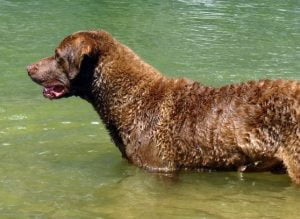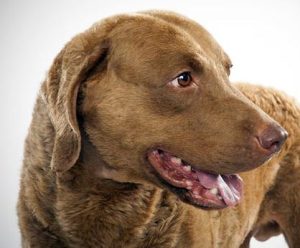Chesapeake Bay Retrievers Dog Breed Information Guide – All About Chespeake Bay Retrievers
The Chesapeake Bay Retriever, an American dog breed, boasts a truly distinctive history. This breed, known for its affection towards children and its love for water, could be the perfect pet for your family. If you’re an active and fun-loving person, the Chesapeake Bay Retriever could be the ideal breed to bring happiness and laughter into your life!
- Chesapeake Bay Retrievers
- Chesapeake Bay Retrievers Dog Breed Information Guide – All About Chespeake Bay Retrievers
- Chesapeake Bay Retriever History
- Chesapeake Bay Retriever Appearance
- Training Your Chessie
- Chesapeake Bay Retriever Temperament
- Does a Chessie Need a Lot of Exercise?
- Caring For Your Chessie
- Chesapeake Bay Retriever Health Considerations
- Is a Chesapeake Bay Retriever the Right Breed of Dog For You?
- More Information about the Chesapeake Bay Retriever Dog Breed
The Chesapeake Bay Retriever is a large-sized breed of dog belonging to the Retriever, Gundog, and Sporting breed groups. Members of the breed may also be referred to as a Chessie, CBR, or Chesapeake. The breed was developed in the United States Chesapeake Bay area during the 19th century. Wikipedia
Hypoallergenic: No
Life expectancy: 10 – 12 years
Origin: Chesapeake Bay
Colors: Deadgrass, Light Brown, Dark Brown, Tan, Brown, Sedge
Temperament: Affectionate, Intelligent, Happy, Quiet, Protective, Dominant
Weight: Female: 25–32 kg, Male: 30–36 kg
Chesapeake Bay Retriever History
The Chesapeake Bay Retriever, often referred to as the “Chessie,” has a rich history dating back to the early 19th century in the United States. This breed was first developed in Chesapeake Bay, Maryland, to assist waterfowl hunters by retrieving game from the water. The breed’s ancestors were two Newfoundland puppies who were rescued from a shipwreck in 1807 and later bred with local retrievers.
The pups were mated with local sporting dogs, thought to be both Curly Coated Retrievers and Flat Coated Retrievers, producing offspring that were legendary sporting dogs, able to withstand the coldest and roughest waters without incident. These dogs eventually came to be considered a breed unto themselves, and the Chesapeake Bay Retriever dog breed was born.
The Chessie was recognized as a distinct breed by the American Kennel Club in 1878. Known for their strength, intelligence, and excellent swimming abilities, the Chesapeake Bay Retriever has served not only as a hunter’s companion but also as a search and rescue dog and a pet. Today, they remain popular for their versatility and their loyal and protective nature.
Chesapeake Bay Retriever Appearance
The Chesapeake Bay Retriever is a large, robust dog breed known for its distinctive appearance. They possess a broad, round skull, medium-sized eyes usually in amber or yellowish shades, and their ears are small and hang down. One of their unique characteristics is their dense double coat, which is slightly wavy and waterproof, designed to withstand cold water and weather conditions.
The coat color can range from dark brown to a light straw shade, but the most common are brown, sedge, or deadgrass. This breed has a strong, muscular build, with males typically weighing between 65-80 pounds and females between 55-70 pounds. Their strong hindquarters and webbed feet make them excellent swimmers, fitting for their reputation as water dogs.
The Chesapeake Bay Retriever is valued more for his talents as a sporting dog than for his appearance. While Chessies are by no means homely in appearance, they possess an oily and somewhat wavy coat which enables them to dry off after a cold swim with a few shakes. The coat is usually dark brown or resembles the color of dead grass, a muted tan.
The Chesapeake Bay Retriever resembles the Labrador Retriever in many ways; the body is roughly the same size and musculature, and the head has a similar appearance. The Chessie also possesses those meaningful brown eyes that always let you know just how much he loves you.

Training Your Chessie
Training your Chesapeake Bay Retriever, affectionately known as a Chessie, requires patience, consistency, and understanding. This breed is known for its intelligence, strength, and versatility, making it a great companion for hunting, water activities, and even as a family pet. However, they also have a strong will and can be quite stubborn, which means training should start at an early age.
Positive reinforcement techniques, such as treats and praises, are often effective. Regular socialization and obedience training can help shape your Chessie into a well-behaved and balanced dog. It’s also important to provide plenty of physical and mental stimulation to keep them happy and healthy.
Chesapeake Bay Retriever Temperament
The Chesapeake Bay Retriever has a temperament that is characterized by its intelligence, toughness, and versatility. These dogs are known to be incredibly loyal and protective of their families, making them excellent guard dogs. However, they are also quite independent and can be somewhat reserved, particularly with strangers.
They are highly trainable, but their independent nature means that they can sometimes be stubborn, so firm and consistent training methods are required. Despite their serious work ethic, they also have a playful side and can be quite affectionate with their loved ones. Their high energy levels and endurance make them great companions for active individuals or families.
Does a Chessie Need a Lot of Exercise?
Yes, a Chesapeake Bay Retriever, often referred to as a Chessie, does need a lot of exercise. These dogs are known for their high energy levels and stamina, having been bred for work such as retrieving game in hunting scenarios. As a result, they require regular, vigorous exercise to keep them physically fit and mentally stimulated.
This can include activities like long walks, runs, swimming, or playing fetch. Without adequate exercise, a Chessie can become bored and potentially destructive. Therefore, they are best suited to homes that can provide them with plenty of physical activity.
Caring For Your Chessie
Caring for your Chesapeake Bay Retriever, affectionately known as a “Chessie,” involves a lot of time, love, and patience. These dogs are known for their intelligence, energy, and strength, so they require plenty of exercise and mental stimulation.
Regular physical activities like walking, running, or playing fetch can keep them physically healthy, while puzzle toys and training sessions can keep their minds sharp.
Chessies are also known for their thick, waterproof coats, which need regular brushing to prevent matting. Additionally, as they are very loyal and protective, socialization from a young age is crucial to prevent any aggression or over-protectiveness.
Regular vet check-ups, a balanced diet, and lots of love and attention are the key components of caring for your Chessie.
Chesapeake Bay Retrievers require very little in the way of grooming. Since they love to swim, a bath is hardly ever necessary. The coat can be kept free of dead hairs with a weekly brushing – a stiff slicker brush is the best tool of choice for grooming a Chessie.
Chesapeake Bay Retriever Health Considerations
Chesapeake Bay Retrievers are generally healthy dogs with a lifespan of 10-12 years. However, like all breeds, they may be susceptible to certain health conditions. These may include hip and elbow dysplasia, a common ailment in larger dog breeds that affects the joints, and progressive retinal atrophy, an eye disorder that eventually leads to blindness.
They may also be vulnerable to gastric torsion, or bloat, a life-threatening condition that affects large, deep-chested dogs. Regular check-ups and screenings can help detect these issues early. Despite these risks, with proper care, diet, and exercise, Chesapeake Bay Retrievers can lead healthy, active lives.
It is extremely important to find a highly responsible breeder from which to purchase a Chesapeake Bay Retriever puppy. A reputable breeder will be very well educated about the Chesapeake Bay Retriever dog breed and carefully screen her breeding dogs for any common canine disorders and congenital problems that may be prevalent in the breed.
Health Problems Which Can Occur in Chesapeake Bay Retrievers include:
- Hip dysplasia
- Progressive retinal atrophy
- Type 3 von Willebrand disease
- Cataracts
- Regional Alopecia
There are no 100% guarantees when it comes to buying a healthy purebred puppy, but acquiring your puppy from a highly responsible breeder who selectively breeds for health and temperament, and who offers, and stands behind a reasonable health guarantee is your best insurance.
Is a Chesapeake Bay Retriever the Right Breed of Dog For You?
Determining whether a Chesapeake Bay Retriever is the right breed for you depends on your lifestyle, living situation, and personal preferences. This breed is known for its intelligence, versatility, and endurance, making it an excellent working dog.
They are also affectionate and protective, forming strong bonds with their family members. However, they require regular exercise and mental stimulation to stay happy and healthy.
They can be somewhat reserved around strangers and may exhibit a strong-willed and independent streak, so they benefit from a confident owner with experience in dog training. If you have the time and energy to devote to their physical and mental needs, a Chesapeake Bay Retriever can be a loyal and loving companion.
More Information about the Chesapeake Bay Retriever Dog Breed



